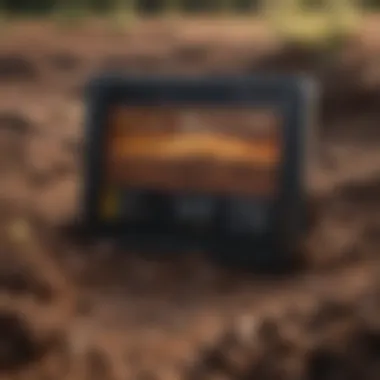Exploring Soil Water Monitors for Sustainable Agriculture


Intro
Soil water monitoring has emerged as a critical component in modern agricultural practices and environmental science. As water resources become increasingly limited, understanding soil moisture dynamics is essential for sustainable land management. Effective soil water monitoring helps in optimizing irrigation, improving crop yields, and conserving precious water resources. This exploration of soil water monitors highlights their methods, significance, and future potential in enhancing agricultural productivity and environmental stewardship.
Research Overview
Key Findings
Recent research indicates that the integration of advanced sensor technologies plays a vital role in real-time soil water management. Studies show that using soil moisture sensors can lead to a reduction in water usage by up to 30%. This indicates not just economic benefits through cost-saving, but also significant environmental advantages. Additionally, data analytics combined with these sensors create actionable insights that allow farmers to make informed decisions about irrigation timing and quantity.
Study Methodology
The methodologies employed in soil water monitoring often involve both qualitative and quantitative approaches. Researchers utilize a combination of lab experiments, field trials, and simulation models to gain comprehensive insights into soil moisture behavior. Key techniques include:
- Remote sensing: Utilizing satellite data for large-scale moisture analysis.
- Soil moisture sensors: Instruments placed at various soil depths to capture moisture data continuously.
- Data analysis: Employing machine learning algorithms to predict moisture trends based on historical data.
These methodologies provide a robust framework for understanding soil water dynamics, vital for improving agricultural practices.
Background and Context
Historical Background
The concept of monitoring soil water content has been around for centuries. Historically, farmers relied on traditional methods like soil feel and appearance to gauge moisture levels. However, the advancement of scientific techniques in the late 20th century paved the way for more reliable methods. The introduction of tensiometers and soil moisture sensors enabled a more precise understanding of moisture conditions, thereby increasing agricultural efficiency.
Current Trends in the Field
Today, the field of soil water monitoring is experiencing transformative changes. With the rise of precision agriculture, there is a growing emphasis on integrating technology with farming practices. Current trends include:
- Smart farming: Utilizing IoT devices to automate irrigation based on real-time data.
- Data-driven insights: Leveraging big data analytics for better resource management.
- Sustainable practices: Focus on minimizing water consumption while maximizing crop efficiency.
The convergence of these trends underscores the importance of soil water monitors as tools for both growers and researchers in their quest for sustainable agriculture.
Preamble to Soil Water Monitoring
Soil water monitoring plays a vital role in understanding agricultural productivity, environmental health, and sustainable resource management. The moisture level in soil affects plant growth, nutrient absorption, and overall ecosystem stability. Given the increasing challenges of climate change, water scarcity, and food security, monitoring soil water has never been more important.
Effective soil water monitoring systems can provide real-time data that helps farmers and researchers make informed decisions. By understanding the water availability in soil, stakeholders can optimize irrigation practices, reduce water waste, and enhance crop yields. This is particularly crucial in regions prone to drought or extreme weather conditions.
Today’s technological advancements have dramatically improved soil water monitoring capabilities, facilitating a more nuanced understanding of soil dynamics. This article not only examines the methodologies used in soil water monitoring but also explores its historical context and evolution, providing a comprehensive picture of how these practices have transformed agricultural techniques and environmental management.
Definition and Importance of Soil Water Monitoring
Soil water monitoring refers to the techniques and technologies used to measure and analyze water content in the soil. This process is crucial for numerous reasons:
- Agricultural Efficiency: Accurate monitoring allows for precision irrigation, ensuring crops receive the appropriate amount of water without waste.
- Environmental Conservation: By understanding soil moisture levels, we can mitigate the impacts of environmental degradation and promote sustainable land management practices.
- Research and Education: Data from soil water monitoring informs research in agriculture, hydrology, and environmental science, providing insights that can lead to better practices and policies.
In essence, soil water monitoring serves as a bridge between scientific research and practical applications in agriculture and ecosystem management.
Historical Context and Evolution of Soil Water Monitoring
The evolution of soil water monitoring can be traced back to ancient agricultural practices. Early farmers utilized rudimentary methods, like visual assessments and simple tools, to gauge the soil's moisture levels. This contradicts the advanced technologies available today.
The 20th century marked a significant transformation in soil monitoring practices. As understanding of soil science grew, scientists developed more sophisticated methods and instruments, such as tensiometers and electric resistance blocks. These innovations enhanced the accuracy of soil moisture measurements, leading to improved crop management techniques.


Today, we see the integration of sensor technologies, data analytics, and IoT solutions in soil water monitoring. This shift towards automation and real-time data collection reflects a broader trend in agriculture towards smart farming solutions. With ongoing advancements, the future of soil water monitoring looks promising, paving the way for innovative applications in sustainable agriculture and environmental conservation.
The Science of Soil Moisture
Understanding soil moisture is crucial for various fields, particularly agriculture and environmental science. It encapsulates how water interacts with soil, influencing plant growth, crop yields, and even ecosystem health. Soil moisture levels are parameters that guide irrigation decisions, thereby directly affecting agricultural productivity. When farmers and researchers monitor soil moisture, they gain insights that can lead to efficient water usage and improved crop management strategies.
Soil moisture not only impacts crop health but also serves a vital role in the hydrological cycle. Properly managed soil moisture levels contribute to sustainable practices, ultimately leading to enhanced water conservation efforts. It is imperative to analyze the dynamics of soil moisture to ensure that these practices are effectively implemented.
Soil Properties Impacting Water Retention
Several soil properties dictate how well water is retained within the soil profile. Key properties include soil texture, structure, and organic matter content. Each of these has a significant influence on the soil's ability to hold and transmit water.
- Soil Texture: This refers to the proportion of different-sized mineral particles in the soil. Coarser sands have larger particles and allow for rapid drainage, while finer clay particles retain water more effectively but can restrict drainage.
- Soil Structure: The arrangement of soil particles into clusters influences water retention. Soils with good structure facilitate water infiltration and retention, while poorly structured soils may become compacted, impeding water movement.
- Organic Matter Content: The presence of organic materials such as decomposed plant matter enhances water retention capabilities. Organic matter improves soil structure, promotes aeration, and enhances microbial activity, which further supports water holding.
These properties collectively determine the water-holding capacity of the soil. Understanding these elements assists agronomists and soil scientists in developing effective moisture management strategies that enhance productivity.
Hydrological Cycle and Soil Water Dynamics
The hydrological cycle describes the continuous movement of water on, above, and below the surface of the Earth. Soil water dynamics are integral to this cycle, impacting various natural processes.
- Evapotranspiration: A combination of evaporation from soil and surfaces, and transpiration from plants, consists of a significant portion of water that returns to the atmosphere, influencing moisture levels.
- Infiltration: This occurs when water enters the soil profile from precipitation. The rate at which water infiltrates is affected by the soil's porosity and texture.
- Percolation: Water that penetrates deeper into the soil layers can eventually reach the groundwater, replenishing aquifers. Understanding this process is crucial for managing both soil moisture and water resources effectively.
Monitoring these dynamics leads to insights on drought management and flood prediction. Implementing soil water monitors can provide real-time data, supporting better decisions and enhancing agricultural resilience.
"Soil moisture monitoring is not just about water, but the lifeblood of agricultural systems and sustainable practices."
Technologies in Soil Water Monitoring
The advent of technology has revolutionized various fields, and soil water monitoring is no exception. Understanding these technologies is crucial for enhancing agricultural productivity and efficient water management. The modern tools available for soil water monitoring enable real-time assessments of soil moisture levels, allowing for precise irrigation management and improved crop health. Technologies can influence decisions that lead to water conservation and sustainable farming practices.
Types of Soil Water Sensors
Soil water sensors are the backbone of effective soil water monitoring systems. They provide essential data regarding moisture levels in the soil, which can be used to make informed agricultural decisions. Different types of sensors each have specific benefits and considerations.
Capacitive Sensors
Capacitive sensors operate based on the dielectric constant of the soil. This key characteristic allows them to measure soil moisture content accurately. The beauty of these sensors lies in their relatively low cost and ease of installation, making them a popular choice among farmers and researchers alike.
One unique feature of capacitive sensors is their ability to work without direct contact with the soil moisture. They can offer continuous monitoring, which is crucial for maintaining optimal soil moisture levels over time. However, their accuracy can be affected by soil salinity and temperature variations, which may serve as disadvantages in certain conditions.
Tensiometers
Tensiometers measure the tension or suction of water that plant roots must exert to extract moisture from the soil. This specific aspect is fundamental in understanding how much moisture is available to plants and can inform irrigation decisions efficiently. The direct measurement of soil water tension makes tensiometers quite accurate and reliable for monitoring various crop types.
One significant characteristic of tensiometers is their ability to reflect real moisture availability to plants rather than just a physical measurement of content. However, they can require more maintenance than other types, as they need to be refilled with water periodically.
Time-Domain Reflectometry
Time-domain reflectometry (TDR) relies on the time it takes for a signal to travel through the soil and back to the sensor. This technique is essential for providing high-frequency measurements of soil moisture levels. TDR is favored for its high accuracy and ability to take readings at various soil depths.
A unique feature of TDR is its ability to assess soil moisture in a non-destructive way, allowing for continuous use without disturbing the soil profile. Nevertheless, the initial setup costs can be higher compared to capacitive sensors or tensiometers, which is a consideration for some users.
Wireless vs. Wired Monitoring Systems
The choice between wireless and wired monitoring systems can significantly impact soil water monitoring's effectiveness and usability. Wireless systems are designed for convenience, as they eliminate the need for physical cabling and allow for flexible sensor placement. Users can access data remotely, which enhances the monitoring experience. However, wireless systems may face issues of signal loss in certain terrains.


On the other hand, wired systems often provide more stable and reliable data transmission, which may be a consideration in precision farming systems that rely significantly on real-time data. However, installation of wired systems can be labor-intensive and costly.
"The choice of monitoring system must align with the specific agricultural context and desired operational flexibility."
Ultimately, understanding these technologies helps provide essential insights into optimizing soil water management practices. Each sensor type and system comes with unique capabilities and challenges, emphasizing the importance of a tailored approach to soil water monitoring.
Data Collection and Analysis Techniques
Data collection and analysis are critical components in soil water monitoring. These techniques provide necessary insights into soil moisture levels, which directly influence agricultural practices and environmental management. Effective data collection allows practitioners to make informed decisions that enhance crop yield, conserve water, and maintain soil health. Understanding the different techniques enables a more robust approach to managing soil resources strategically.
Methods of Data Collection
Real-Time Monitoring
Real-time monitoring is an essential method in soil water monitoring. It provides continuous data on moisture levels, ensuring immediate awareness of changing conditions. This method greatly contributes to improved decision-making in irrigation management. A key characteristic of real-time monitoring is its ability to transmit data instantly, allowing for prompt interventions. This immediacy is a beneficial aspect for farmers seeking to optimize water usage efficiently.
The unique feature of real-time monitoring is its integration with technologies such as wireless sensors, providing accessibility and convenience. Advantages include the ability to detect moisture fluctuations and responding proactively. However, it can be limited by connectivity issues and higher initial costs of setting up the systems.
Sampling Techniques
Sampling techniques offer a systematic approach to collecting soil moisture data. This method helps understand moisture distribution and variability across different soil types. The key characteristic of sampling techniques is their ability to gather data from various depths and locations, providing a comprehensive view of soil conditions. This approach is beneficial for crop management because it aids in identifying zones that require specific irrigation strategies.
A unique feature of sampling techniques is the ease of implementation in conjunction with laboratory analyses, which can yield detailed insights into soil water retention capabilities. The advantages of this method include flexibility and cost-effectiveness. On the downside, sampling can be labor-intensive and may not reflect real-time moisture changes, potentially leading to delayed responses in critical situations.
Remote Sensing Approaches
Remote sensing approaches leverage technology to assess soil moisture over large areas without direct contact. This method contributes significantly to soil water monitoring by enabling comprehensive landscape assessments. A key characteristic is the ability to gather data from aerial and satellite imagery, which provides a macro view of moisture distribution. This feature is particularly beneficial for large-scale agricultural operations where on-ground monitoring is impractical.
The unique aspects of remote sensing include the capability to cover vast regions rapidly and track moisture trends over time. The advantages of this method are its efficiency and the ability to integrate data with Geographic Information Systems (GIS) for enhanced analysis. However, challenges may arise from factors like cloud cover or sensor calibration issues, which can limit data accuracy.
Data Interpretation and Reporting
Data interpretation plays a vital role in translating collected soil moisture data into usable information. Users must understand how to analyze the data effectively to draw meaningful conclusions. Proper reporting mechanisms ensure that stakeholders receive relevant information promptly. Focusing on these elements enhances the overall usefulness of the data collected, leading to better agricultural and environmental outcomes.
Applications of Soil Water Monitors in Agriculture
Soil water monitors play a crucial role in agriculture by providing real-time data about soil moisture levels. This information is vital for making informed decisions that impact crop health, irrigation strategies, and overall farm management. Understanding how these monitors are applied in agriculture helps farmers optimize their resources while improving yield and sustainability.
Precision Agriculture and Irrigation Management
Precision agriculture utilizes soil water monitors to create a more efficient irrigation strategy. Farmers can obtain specific readings of soil moisture at varying depths. This level of detail enables them to apply water precisely where and when it is needed. As a result, both water and money are saved.
For example, a farmer can avoid over-irrigating in wet areas while providing more water to drier regions. Additionally, integrating soil water data with weather forecasts allows for better planning of irrigation schedules. By doing this, farmers not only conserve water but also enhance crop resilience against droughts or excessive rainfall.
Impact on Crop Yield and Quality
The health of crops heavily depends on moisture levels in the soil. Consistent monitoring helps ensure that crops receive equal access to water. When plants experience water stress, their yield and quality can suffer significantly. By using soil water monitors, farmers can adjust their practices based on the precise needs of their crops, improving both quantity and quality.
Research shows that crops grown under optimal moisture conditions produce higher yields and better-quality fruits or grains. With soil water monitors, farmers can track the conditions of their fields closely, leading to timely interventions.
Soil Health and Nutrient Management
Maintaining soil health is another significant benefit of using soil water monitors. These devices help prevent over-watering, which can lead to leaching of essential nutrients from the soil. By managing water levels effectively, farmers can maintain a healthy balance of nutrients that promotes strong plant growth.
Additionally, understanding the moisture content helps in planning fertilization schedules. Certain nutrients are more available to plants at specific moisture levels. Consequently, soil water monitors can aid in determining the right moment to apply fertilizers, ensuring that crops receive the needed nutrients when they can use them the most.
"Efficient water management leads to sustainable farming practices that are essential in today's water-scarce world."
In summary, the integration of soil water monitors provides solutions that enhance precision irrigation, improve crop yield and quality, and support soil health. These applications make soil water monitoring indispensable for modern agricultural practices.
Challenges in Soil Water Monitoring


Effective soil water monitoring is vital for sustainable agriculture and environmental health. However, this field faces various challenges that can hinder its effectiveness and adoption. Understanding these challenges is crucial for improving current practices and implementing future technologies.
Technical Limitations of Current Technologies
Soil water monitoring technologies, despite advancements, still show some significant limitations. One of the primary issues is the variability in soil types and conditions, which can lead to inaccurate readings. Many sensors may not perform well in all soil environments, reducing their reliability.
- Calibration Issues: Sensors require regular calibration to maintain accuracy due to physical changes in the soil and weather conditions.
- Depth Limitations: Many sensors only measure moisture at specific depths. Since root zones can vary, critical information might be lost if the sensor is not at the right depth.
- Sensor Lifespan: Some technologies, such as tensiometers, can be susceptible to wear and damage from environmental conditions, leading to maintenance challenges.
- Power Dependency: Battery-operated sensors face limitations in remote locations where power sources are scarce. This requirement restricts their usability.
The outcomes of these limitations can affect crop management decisions. Farmers may rely on faulty data, which can lead to improper irrigation strategies and negatively impact yields.
Data Integration with Agricultural Practices
The integration of soil water monitoring data with broader agricultural practices is another challenge. Farmers often struggle with how to act on the information provided by these monitoring systems.
- Data Overload: The sheer volume of data generated can be overwhelming. Farmers may not have the time or resources to analyze all relevant data, leading them to make decisions based on incomplete information.
- Lack of Standardization: Different soil moisture sensors can produce varied data interpretation formats. This inconsistency creates difficulty in comparing data and understanding trends.
- Training and Education: Many farmers and agricultural professionals lack proper training in analyzing soil moisture data. Without adequate education, they might miss out on valuable insights that could improve their practices.
To address these challenges, it is imperative to develop user-friendly systems that not only capture data but also provide actionable insights. Collaborations between tech companies and agricultural experts can lead to better user interfaces and training programs. Ultimately, overcoming these challenges will help maximize the benefits of soil water monitoring, enhancing agricultural productivity and sustainability.
"Effective integration of soil water monitoring with practical farming techniques is crucial for advancing agricultural efficiency."
Adapting agricultural practices based on reliable data is key to achieving optimal watering strategies, enhancing crop health, and promoting sustainable resource usage.
Future Trends in Soil Water Monitoring
The realm of soil water monitoring is on the cusp of remarkable transformations. As agricultural challenges escalate due to climate change and increasing food demands, the adoption of advanced technologies becomes paramount. Future trends in soil water monitoring offer a glimpse into innovative methodologies that can enhance efficiency and sustainability in agricultural practices. Understanding these trends is crucial for researchers, educators, and agricultural professionals as they seek to navigate the complexities of modern farming.
Advancements in Sensor Technologies
Recent innovations in sensor technologies are redefining how soil moisture is monitored. Enhanced sensors are more accurate, reliable, and capable of providing real-time data. Important advancements include
- Multi-sensor Systems: These systems gather data from various types of soil moisture sensors, improving the reliability of measurements through triangulation of data points.
- Low-Power Wide-Area Network (LPWAN) Technologies: These technologies extend battery life while maintaining connectivity over large areas, making it easier to monitor field conditions without frequent maintenance.
- Smart Sensors with Built-in AI: The application of artificial intelligence in sensor systems allows for predictive analytics, enabling farmers to forecast irrigation needs and optimize water usage based on changing conditions.
As sensor technologies integrate these advancements, they cater to a growing need for precision and adaptability in soil water monitoring. The benefits of these technological improvements extend beyond mere data collection; they also foster a deeper connection between farming practices and environmental stewardship.
Integration with Smart Farming Solutions
The merging of soil water monitoring with smart farming solutions represents a pivotal shift in agricultural practices. These solutions leverage Internet of Things (IoT) devices, data analytics, and machine learning to facilitate informed decision-making. Advantages of this integration include:
- Automated Irrigation Systems: With real-time data from soil sensors, farmers can automate their irrigation systems, ensuring that water is applied only when needed, thus conserving resources.
- Data-Driven Decision Making: Access to comprehensive data analytics enables farmers to make timely decisions regarding fertilization, crop rotation, and pest management, ultimately optimizing crop yields.
- Sustainability Metrics: Smart farming solutions can track metrics related to soil health and water usage, enabling farmers to make choices that support long-term sustainability goals.
In summary, the future of soil water monitoring is rich with potential. The advancements in sensor technologies and their integration into smart farming practices are crucial for addressing the challenges faced in agriculture today. A proactive approach to adopting these technologies is essential for promoting sustainability and maximizing agricultural productivity in a rapidly changing world.
End
In this article, we examined the multifaceted role of soil water monitoring, emphasizing its critical importance in both agriculture and environmental conservation. Soil water monitors serve as key instruments, not just in measuring moisture levels, but in enhancing understanding of soil health, guiding irrigation practices, and ultimately promoting sustainable agriculture. The data collected through various monitoring techniques has far-reaching benefits. It informs better decision-making, optimizes resource use, and fosters resilience against climate variability.
Summary of Key Insights
The insights gathered from this article can be summarized as follows:
- Soil Water Monitoring Significance: It is essential for effective water management and sustainable practices.
- Technological Diversity: A range of sensor technologies, including capacitive sensors and tensiometers, exist to cater varied monitoring needs.
- Data Analysis Importance: Real-time data analysis allows farmers and researchers to make informed decisions swiftly and accurately.
- Application in Agriculture: Soil monitors directly improve precision agriculture, influencing crop yield and quality.
- Future Trends: Continual advancements, such as integration with smart farming solutions, point towards a more automated agricultural landscape.
The summarized insights underscore the necessity for soil water monitoring systems, which are instrumental in ensuring efficient agricultural practices and conservation efforts.
The Role of Soil Water Monitoring in Sustainable Practices
Soil water monitoring stands at the intersection of agricultural productivity and environmental sustainability. Its implementation leads to defining how much water is used and how effectively it is being utilized. This allows for the conservation of water resources by reducing unnecessary applications of water. Additionally, soil monitors help in maintaining soil health by ensuring that crops receive the appropriate amount of moisture without over-saturation, which can lead to nutrient leaching.
More importantly, as climate change increasingly impacts weather patterns and agricultural outputs, soil water monitors provide real-time data that equips farmers with the ability to adjust irrigation and farming practices responsively. This adaptive approach allows for mitigation of climate-related risks, helping farmers remain resilient.
In summary, the integration of soil water monitoring into farming practices significantly contributes to sustainable agriculture. This not only addresses water scarcity challenges but also promotes responsible land stewardship and environmental health.







